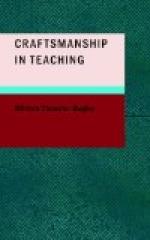IV
But perhaps you would maintain that this statement of the case, while in general true, does not help us out in practice. After all, how are we to impress pupils with this ideal of persistence and with these ideals of getting and applying information, and with this ideal of investigation? I maintain that these important useful ideals may be effectively impressed almost from the very outset of school life. The teaching of every subject affords innumerable opportunities to force home their lessons. In fact, it must be a very gradual process—a process in which the concrete instances are numerous and rich and impressive. From these concrete instances, the general truth may in time emerge. Certainly the chances that it will emerge are greatly multiplied if we ourselves recognize its worth and importance, and lead our pupils to see in each concrete case the operation of the general principle. After all, the chief reason why so much of our education miscarries, why so few pupils gain the strength and the power that we expect all to gain, lies in the inability of the average individual to draw a general conclusion from concrete cases—to see the general in the particular. We have insisted so strenuously upon concrete instruction that we have perhaps failed also to insist that fact without law is blind, and that observation without induction is stupidity gone to seed.
Let me give a concrete instance of what I mean. Not long ago, I visited an eighth-grade class during a geography period. It was at the time when the discovery of the Pole had just set the whole civilized world by the ears, and the teacher was doing something that many good teachers do on occasions of this sort: she was turning the vivid interest of the moment to educative purposes. The pupils had read Peary’s account of his trip and they were discussing its details in class. Now that exercise was vastly more than an interesting information lesson, for Peary’s achievement became, under the skillful touch of that teacher, a type of all human achievement. I wish that I could reproduce that lesson for you—how vividly she pictured the situation that confronted the explorer,—the bitter cold, the shifting ice, the treacherous open leads, the lack of game or other sources of food supply, the long marches on scant rations, the short hours and the uncomfortable conditions of sleep; and how from these that fundamental lesson of pluck and endurance and courage came forth naturally without preaching the moral or indulging in sentimental “goody-goodyism.” And then the other and equally important part of the lesson,—how pluck and courage in themselves could never have solved the problem; how knowledge was essential, and how that knowledge had been gained: some of it from the experience of early explorers,—how to avoid the dreaded scurvy, how to build a ship that could withstand the tremendous pressure of the floes;




